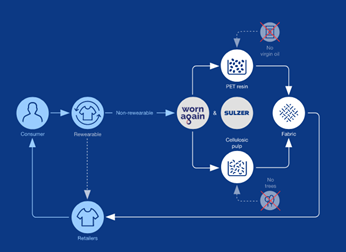Groundbreaking textile recycling technology
Who doesn’t love the sight of a decluttered wardrobe? Since Netflix made the renowned tidying expert Marie Kondo and her organizing method popular across the globe, decluttering has become an expression of contemporary lifestyle. Even more so in times of the pandemic, with more people staying at home and tidying up.
But what to do with all the pieces that – in the words of Kondo – no longer “spark joy”? Although secondhand fashion is increasing in popularity again, most clothing still ends up being thrown away.
Three-quarters of clothing end up in landfills
Of the more than 60 million tons of natural and synthetic textile fibers that are produced for clothing every year, 73% is incinerated or landfilled, according to the Ellen MacArthur Foundation.
While it is common in many countries to recycle materials such as plastic, glass and paper, it is estimated that only 1% of clothing is recycled into new garments. Why is that? Textiles are rather complex systems containing various types of fibers, dyes, fillers and additives, making them difficult to recycle into virgin-like raw materials.
Initiating the textile revolution
As an expert in separation and chemical recycling technologies, we have taken up the challenge of solving this pressing environmental issue. Sulzer and H&M together control the UK-based company Worn Again. The teams are working on a unique textile recycling process to convert textiles at their end of use back into virgin-like raw materials.
From old to new
Sulzer, together with H&M and Worn Again, has developed a new recycling process for the textile industry. The key is separating and recovering PET – a common component of clothes – and cotton or other cellulosics from end-of-use textiles. But the chemical processes behind this novel technology are complex.
Polyester textiles are complex materials containing different types of fibers, dyes, fillers and additives. PET is a type of polyester and serves as the basis for many clothes. However, most garments consist of a mix of different materials; the majority are so-called PET/cotton blends.
How chemical recycling of textiles works
The chemical recycling process is complex: In the first step called “dissolution”, solvents are used to dissolve the PET material and remove dyes, catalysts and other organic additives. Other chemicals remove the dyes from the cellulosic fibers.
The insoluble additives are released as fine powders and removed in a filtration process. The result is two products: 100% PET resin chips on the one hand and a cellulosic pulp on the other hand, which can be re-spun into a cellulosic fiber. In other words, the output is virgin PET and cellulose that can be reused to produce new garments.
The teams are also researching how to treat the by-products that arise in the process (such as dyes or surface finishes) and to refine them into useful end products instead of incinerating or landfilling.
Unique recycling technology
Our technology is unique because it does not actually change the chemical composition of the material and separates the PET and cotton/cellulose in one process in contrast to other recycling practices, saving energy.
With the new demonstration facility, the teams will further develop the technology and scale up operations to make it commercially available.Scaling-up a novel recycling process
Sulzer provides the equipment, technology and expertise which is combined with Worn Again’s unique solvent technology to form the heart of the process. Converting end-of-use polyester and cotton garments into polyester pellets and cellulosic pulp that can further be re-spun into new fibers, our technology closes the loop in the textile industry.After extensive R&D, the results from the pilot plant have been promising. Our experts are now engineering a larger demonstration plant to further scale-up the technology to an output of a thousand tons a year, the final proof of concept before commercialization.
Sulzer and H&M are just about to allow your old clothes to be Worn Again!
